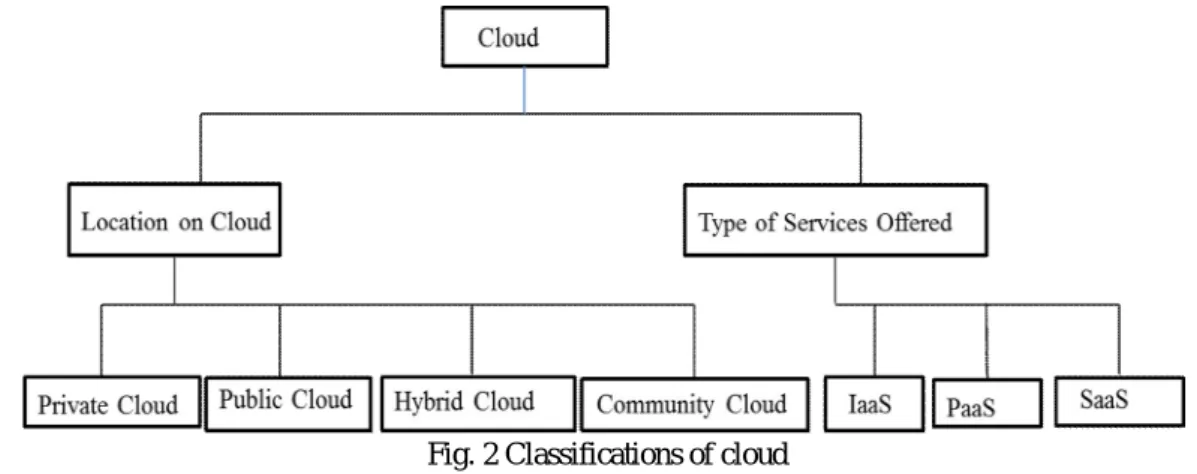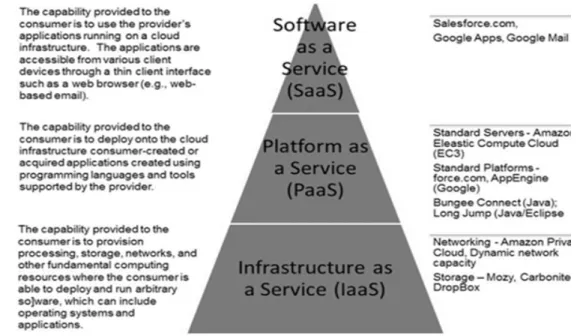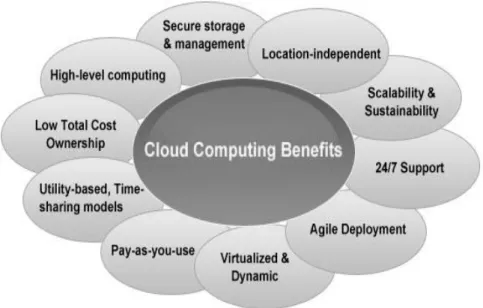_________________________________________________________________________________________________
© 2014-15, IRJCS- All Rights Reserved Page -79
A Study of Cloud Computing
Rafiqul Zaman Khan Md Firoj ALi
Department of Computer Science, AMU Department of Computer Science, AMU
Abstract— Cloud computing has become the most attracting field of computing as proposed by Google in 2007. Cloud computing provides the computing infrastructure, storage and any type of applications from audio to word processors what even we can imagine. Cloud computing is capable of assigning the required resources to any client on demand. The clients do require neither any cost for computing infrastructure building nor maintenance cost of any hardware or software that removes the huge financial burden and mental stress on them. The clients only need to connect their computers or networks to the cloud computing servers. In this paper we focused on the need of cloud computing, architecture of cloud computing, types of cloud, services provided by clouds and the offerings of cloud computing. Keywords— Cloud, public cloud, private cloud, hybrid cloud, community cloud, IaaS, PaaS, SaaS
I. INTRODUCTION
Every organization either business or education needs IT infrastructure (hardware and software) for computing and storage for carrying out their day to day work. An organization may need different hardware or software for different types of applications which means new software must have to buy each time when there may be changes in applications. Buying only the computers for the employees in an organization is not enough as the new applications may need new software which may be of very high cost or the software license may not permit more than one user to install. Besides, the most important factor is the maintenance of both the hard ware as well as software is always very high as compared to the installation cost of the same. So there is a lot of burden in terms of cost and stress on the IT personal responsible for managing the IT infrastructure in an organization.
Thus the concept of cloud computing is emerged to overcome the above problems. On demand delivery of computer resources –everything like computing, storage and software etc. is known simply as cloud computing [1], [2]. It is called cloud computing as data and applications exist on a cloud of web server. If an organization’s computers are connected to the cloud computing server, the organization does not need to install a suite of software for each computer rather to load one application which would allow clients to log into a web-based server which hosts all the software that is enough for the client’s need [1], [2], [3], [4].
A significant workload shift takes place in cloud computing which is dealt by the computer of the network that builds the cloud. The demand for hardware and software decreases in the client side as the clients need to run only cloud computing systems’ software that may be simply as a web browser. A simple example of cloud computing is Gmail, Yahoo mail or Hotmail. We do not need any software or server to send or receive the emails. It only needs to log on into their server through any browser having internet connection. Server, server software hardware and email management software are managed by the cloud service providers like Google, Yahoo etc [3], [4]. So the clients only to have internet connection and there is no need to by any hardware or software for emailing.
II. CLOUD COMPUTING ARCHITECTURE
Cloud computing mainly consists of two parts: the front end and back end. The front end is the client’s computer or computer network at remote side. On the other side, back end includes the various computers, servers and data storage systems that that makes the cloud for computing services. Cloud computing may include any software like data processing to video games. In general, each application runs on its own dedicated server. Fig. 1 shows a typical model for cloud computing.
In a cloud, a central server manages the cloud computing by monitoring traffic and client demands to make ensure everything runs properly by following some protocols and using a special type of software called middleware. Cloud computing needs huge computing storage as the cloud computing company in general has huge numbers of clients. The cloud computing needs to copy the client’s data at least once to another device on another place in order to live the system during breakdown as cloud computing networks are very occasionally break down.
_________________________________________________________________________________________________ © 2014-15, IRJCS- All Rights Reserved Page -80
Fig. 1 A model of cloud computing III. CLASSIFICATION OF CLOUD COMPUTING
Cloud computing is usually classified on the basis of location of cloud and the type of service provided by a cloud [5]. Fig. 2 shows the classification.
Fig. 2 Classifications of cloud
A. Location Based Cloud
Cloud computing is typically classified in the following three ways on the basis of location of a cloud [5].
1) Public Cloud: Public cloud is owned by the cloud service provider companies. The clients have no authorization to control the cloud rather they just enjoy the services provided by the cloud although it seems to the clients that everything is running smoothly at their own computer due to the virtualization of the cloud infrastructure. Users don’t need to buy hardware, software or supporting infrastructure, which is owned and managed by providers with public cloud services,. The cloud computing in general is shared by several organizations. Google, Amazon, Yahoo, SUN etc. are the example of public cloud service provider.
2) Private Cloud: The private cloud is either owned by the company itself for its use or it may be hosted by third party but used by various lines of business and constituent groups.. Private cloud is more expensive as compared to public cloud. Private clouds have two instances: On-premise private clouds and externally hosted private clouds. Both types of clouds are used by one organization but externally hosted private cloud is hosted by other organizations that have enough experience in cloud infrastructure. On-premise private clouds are more expensive than externally hosted private clouds.
3) Hybrid Cloud: When both the private cloud and public cloud together is used, is called hybrid cloud or also called Cloud Bursting. Own computing infrastructure for normal use is being used by cloud bursting organization but uses also public clouds in case of sudden increase in computing requirement for smooth working of the organization.
4) Community Cloud: In community cloud, computing infrastructure is being shared by the organizations belonging to the same community. For example all Government organizations may share the same cloud to fulfill the requirements of a state.
_________________________________________________________________________________________________ © 2014-15, IRJCS- All Rights Reserved Page -81
B. Classification Based on Service Provided by Clouds
Clouds are classified in the following ways based on the services provided which summarized by Fig 3.
1) Infrastructure as a Service (IaaS): Infrastructure providers host a large set of computing resources like computing resources including servers, networking, storage and data center space on a pay-per-use basis [3], [4], [6], [7], [8], [9]. These resources are dynamic in nature and they can be split, assigned and resized to make available to the clients as their requirements. Vendors like Amazon Elastic Compute Cloud, Amazon S3, IBM’s Blue Cloud, Rackspace Cloud Servers and Flexiscale provides this type services to the clients.
2) Platform as a Service (PaaS): Platform as a service offers a cloud-based environment that supports the complete lifecycle of building and delivering web-based applications without purchasing and managing the essential hardware, software and hosting cost [3], [4], [6], [7], [8], [9].
3) Software as a service (SaaS): It offers the software as a service on the cloud. Clients may access any software applications as they require or may run their applications or programs in the cloud via internet that may be hosted and maintained [3], [4], [6], [7], [8], [9].
Fig. 3 Service model view of cloud computing
IV. VIRTUES OF CLOUD COMPUTING
There are five important features which are defined by National Institute of Standard and Technology (NIST) [5] of cloud computing are as follows:
A. On Demand Self Service
A consumer can individually deliver computing capabilities [5].
B. Broad network access
Capabilities are available over the network and accessed through standard mechanisms that promote use by heterogeneous thin or thick client platforms [5].
C. Resource pooling
Multiple consumers are served by resource pooling with virtualized resources which are dynamically assigned and reassigned according to consumer demand [5].
D. Rapid Elasticity
Capabilities can be rapidly and elastically provisioned, in some cases automatically, to quickly scale out and rapidly released to quickly scale in [5].
E. Measured service
Cloud computing systems are automatically controlled and optimized to some level of abstraction to handle the situation [5].
V. CLOUD COMPUTING OFFERINGS
It has been noticed that the offerings of internet services on demand has been highly increased today and the trend will be more and more in future.
_________________________________________________________________________________________________ © 2014-15, IRJCS- All Rights Reserved Page -82 The leading service providers like Salesforce, Google, SUN, Amazon, IBM, Oracle etc. are providing cloud computing services for storage, database, computation and applications. Application services may be any type of services like video, audio, data processing, email, office applications, finance, business process management, marketplace, billing, accounting, email, data sharing, data processing and web services etc [10], [11], [12]. The Table 1[12] provides service provider name, type of service they provide, pricing model they follow and cloud business model framework (CBMF) about the leading cloud computing service provider. Fig. 4 depicts the benefits of cloud computing.
Fig. 4 Benefits of cloud computing
VI. CONCLUSIONS
It has been noticed that the offerings of internet services on demand has been highly increased today and the trend will be more and more in future. On demand delivery of computer resources –everything like computing, storage and software etc. is known simply as cloud computing.
_________________________________________________________________________________________________ © 2014-15, IRJCS- All Rights Reserved Page -83 The clients do require neither any cost for computing infrastructure building nor maintenance cost of any hardware or software that removes the huge financial burden and mental stress on them. The clients only need to connect their computers or networks to the cloud computing servers and to pay service charges by simple payment methods like pay-per-use or subscription method. In this paper we focused on the need of cloud computing, architecture of cloud computing, types of cloud, services provided by clouds and the benefits or offerings of cloud computing.
REFERENCES
[1] N. Sadashiv and S. D. Kumar, "Cluster, grid and cloud computing: A detailed comparison," in Proc. the 2011
6th International Conference on Computer Science and Education (ICCSE), 2011, pp. 477-482.
[2] K. Kaur and A. K. Rai, "A comparative analysis: Grid, cluster and cloud computing," Lecture Notes in
Computer Science, pp. 341-342, 2010.
[3] I.Nwobodo, H. Jahankhani, and A. Edoh, "Security challenges in the distributed cloud computing,"
International Journal of Electronic Security and Digital Forensics, vol. 6, no. 1, pp. 38-51, 2014.
[4] G. Suciu, S. Halunga, A. Apostu, A. Vulpe, and G. Todoran, "Cloud computing as evolution of distributed computing–A case study for slapos distributed cloud computing platform," InformaticaEconomica, vol. 17, no. 4, pp. 109-122, 2013.
[5] A. W. Khan, S. U. Khan, M. Ilyas and M. I. Azeem. A Literature Survey on Data Privacy/Protection Issues and Challenges in Cloud Computing. IOSRJCE, vol1, pp.28-36, 2012.
[6] Khalid and M. Shahbaz, "Cloud computing technology: services and opportunities," Pakistan Journal of Science, vol. 65, no. 3, 20131.
[7] T. Mather, S. Kumaraswamy, and S. Litif, Cloud Security and Privacy: An enterprise perspectives on Risks and
Compliance (Theory in Practice ). O' Reilly, 2009.
[8] B.P.Rimal, E.Choi, and I.Lumb. A taxonomy and survey of Cloud Computing Systems. in Networked Computing
and Advanced Information Management, International Conference. 2009.
[9] M.Peter and G. T, The NIST definition of Cloud Computing. 2009.
[10] M. V. Luis, R. M. luis, C. Juan and L. Maik. A Break in Clouds: Towards a Cloud Definition. Computer Communication Review, vol39, pp50-55,2009.
[11] Amazon Elastic MapReduce. http://aws.amazon.com/elasticmapreduce,2010.9.26.
[12] Weinhardt et al. Cloud Computing-A Classification, Business Models, and Research Directions. Business and Information Systems Engineering, 2009.
Dr. Rafiqul Zaman Khan received his B.Sc Degree from G.M.J.P Rohilkhand University, Bareilly, M.Sc and M.C.A from A.M.U. Aligarh and Ph.D (Computer Science) from Jamia Hamdard University, New Delhi. He has 21 years of Teaching Experience of various reputed International and National Universities viz King Fahad University of Petroleum & Minerals (KFUPM), K.S.A; Ittihad University (IU), U.A.E; Pune University, Pune; Jamia Hamdard University, New Delhi; and A.M.U, Aligarh. He worked as a Head of the Department of Computer Science at Poona College, University of Pune and Chairman of the Department of Computer Science, AMU, Aligarh. His Research Interest includes Parallel & Distributed Computing, Gesture Recognition, Expert Systems, IPv6 Security & Cloud Computing. He has published about 60 research papers in International Journals/Conferences. Number of students completed their PhD under his supervision. Dr. Khan is the Member of Advisory/Editorial Board of number of International Journals.
Dr. Md Firoj Ali: is presently working as an Assistant Engineer (IT & C) in WBSEDCL, West Bengal, India. He received his B.Sc. and MCA Degree from A.M.U. He has been awarded Senior Research Fellowship by UGC, India and also cleared National Eligibility Test conducted by UGC, 2012 and SET 2013. His Research Interest includes Load balancing in Distributed Computing System. He has published ten research papers in International Journals/Conferences.


